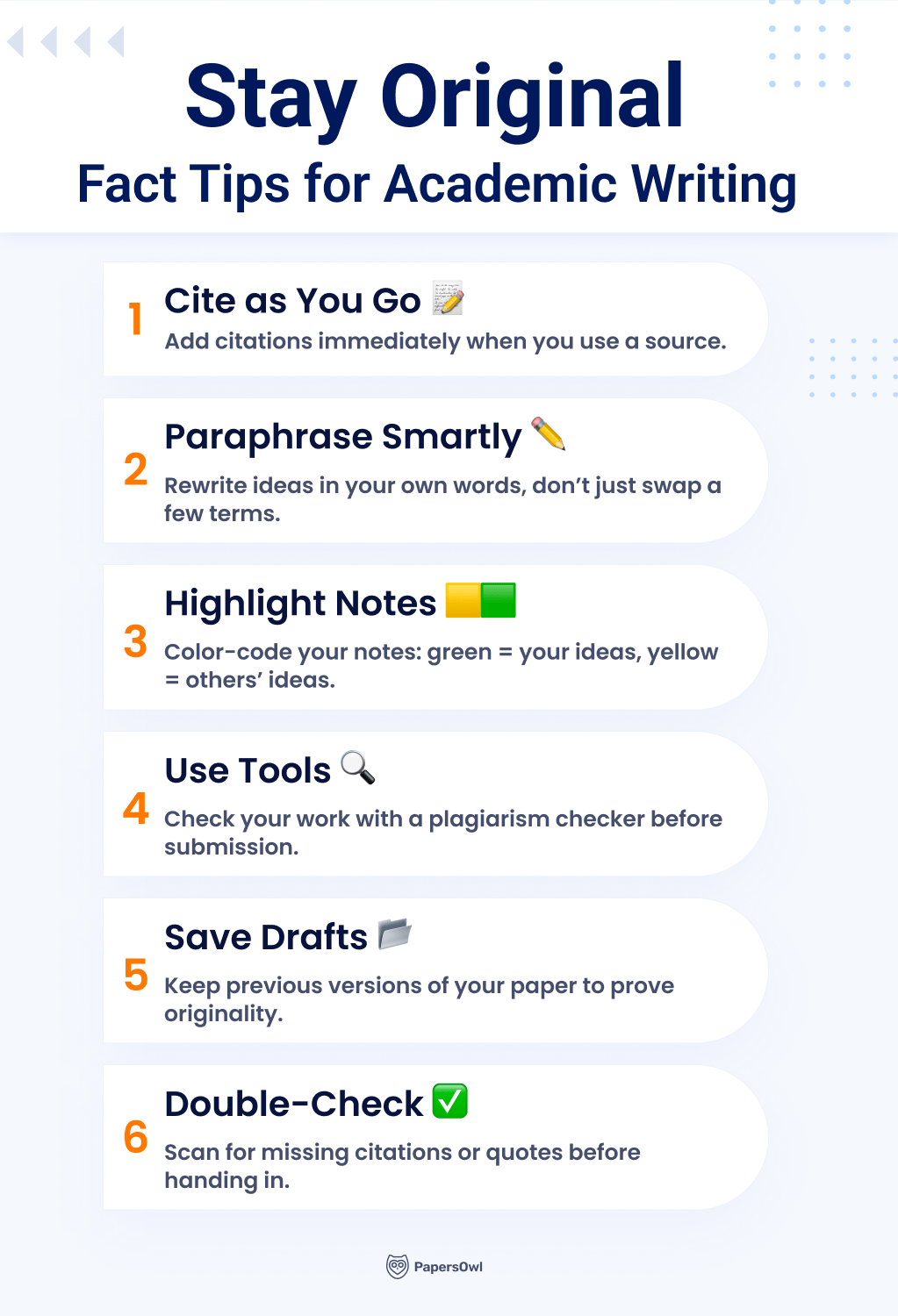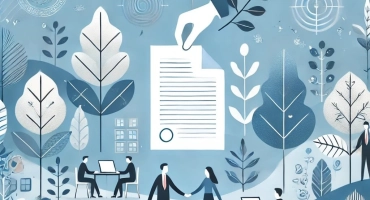How to Avoid Plagiarism in Academic Writing?
Table of contents
In scientific works, originality is more than just a formality — it forms the backbone of credibility, peer trust, and long-term academic standing. Before we explore techniques to protect your work, it’s essential to clarify what is plagiarism mean and why it matters.
Intellectual dishonesty occurs when a writer uses someone else’s words, ideas, definitions, or notes without giving proper credit. This could be as obvious as copying entire paragraphs, or as subtle as reusing phrases without quotation marks or missing page numbers in a reference. Even unintentional mistakes — like failing to cite an example correctly — can damage a student’s academic standing.
If the complex citation rules, especially for APA format, are a major source of error and worry, finding an expert to write my APA paper for me can be a safer option.
Recent studies highlight the issue: surveys suggest that up to 36% of students admit to some form of academic dishonesty during their studies. For example, several universities have reported cases where students were expelled or lost scholarships due to repeated plagiarism violations.
For this reason, this article aims to offer practical guidance to help students avoid plagiarism, defend their reputations, and write confidently!

4 Core Strategies to Prevent Intellectual Dishonesty
Prevention of intellectual dishonesty does not mean avoiding sources — it’s about using them responsibly. There are proven ways to avoid plagiarism, whether working on a short essay or a large research paper.
Here are the core strategies every writer should follow:
- Cite sources correctly.
- Use in-text citations and include full references.
- Record numbers of pages for direct quotations and longer passages.
- Be consistent with your chosen style (APA, MLA, Chicago).
- Paraphrase in your own words.
- Express the original source’s ideas without repeating exact words.
- Change the structure, not just a few words.
- Always provide a citation even when paraphrasing.
- Integrate quotations ethically.
- Place quotation marks around the author’s words.
- Add a clear reference immediately after the quotation.
- Blend direct quotations with your own analysis.
- Draft carefully and review.
- Take notes during research to avoid copying directly.
- Highlight your own ideas versus other people’s ideas.
- Use plagiarism-detection tools before submission.
Paraphrasing Without Losing Meaning
One of the most effective tips to avoid plagiarism is paraphrasing. To paraphrase means restating someone else’s ideas in your own words and language. However, it’s easy to misuse. Changing only a few words from the original sentence is not true paraphrasing and still counts as academic dishonesty.
Paraphrasing means restating ideas in your own words while keeping the original meaning intact. A common mistake students make is only changing several words, which still counts as academic dishonesty.
Wrong paraphrase (too close to original):
Original: Academic dishonesty can damage a student’s academic reputation and lead to disciplinary action.
Paraphrase: Academic dishonesty may harm a student’s reputation at school and result in punishment.
👉 This is plagiarism because it copies structure and phrasing too closely.
Right paraphrase (idea in your own voice):
Students who commit plagiarism risk losing the trust of their professors and may face serious academic penalties.
👉 This is acceptable because the idea is preserved, but the wording and sentence structure are genuinely different.
Always:
- Use different phrases and sentence structures.
- Put paraphrased material in your own language.
- Include a citation, just as you would with a direct quotation.
For a broader context, academic dishonesty also happens in creative fields like design or painting. See how to manage it in our guide on how to avoid plagiarism in art.
Quoting Correctly and Ethically
Quotations are powerful when used with care. To understand how to avoid plagiarism in research, you must know when — and how — to quote an author’s exact words.
Best practices for quoting:
- Always enclose the author’s words in quotation marks.
- Add citations with the page number right after the quotation.
- Use quotations sparingly; overusing them can weaken your own voice.
- If you borrow unique words or specialized language, credit the original source.
When quoting directly, it’s important to show exactly what belongs to the author and what has been adjusted for clarity.
- Keep the author’s name in the sentence: As Smith (2020) explains, “ethical writing builds trust between the researcher and the audience.”
- Use ellipses (…) to shorten a quote without changing its meaning: Johnson (2019) argues that “students must learn proper citation habits…to avoid unintentional plagiarism.”
- Use brackets [ ] to clarify words, but never to alter meaning: According to Brown (2021), “[digital tools] can help identify possible academic dishonesty before submission.”
👉 These techniques keep your paper precise while ensuring you respect the original author’s message.
Even when quoting, balance it with paraphrased material and your own analysis. That combination proves you understand the source rather than simply copying it.
Balancing Originality and Sources
The best paper is a combination of your own ideas and carefully integrated others’ ideas. This balance is the key when you wonder how to prevent plagiarism.
Guidelines for maintaining originality:
- Use your voice first: Start paragraphs with your analysis and ideas, not someone else’s.
- Support, don’t replace: Sources should support your arguments, not become the paper itself.
- Understand common knowledge: Facts widely known (e.g., “The Earth orbits the Sun”) don’t need citations.
- Avoid over-dependence: Too much reliance on sources, even cited, reduces originality.
By blending your insights with paraphrased material and occasional quotations, you’ll follow plagiarism best practices while preserving originality.
Whenever possible, use open-access sources or materials that clearly allow citation. This ensures your references are transparent and verifiable.
Note-Taking and Drafting Techniques
Many cases of what is plagiarism in research stem from sloppy note-taking during the writing process. When students copy from websites or research notes without marking whether words are theirs or not, confusion arises later.
Effective strategies for taking notes:
- Separate your own ideas from those of others in your notes.
- Highlight others’ ideas with quotation marks and add page numbers immediately.
- Summarize in your own words while you take notes — don’t copy and paste.
- Use digital tools (Google Docs, OneNote) that track your writing process.
- Draft in stages: outline → notes → writing → revising.
By clearly organizing your research notes, you avoid mixing someone else’s thoughts with your own, reducing the risk of academic dishonesty.
Self-Checking Before Submission
Even with good practices, mistakes happen. Before you submit your assignment, verify that you haven’t left any inaccurate citations or accidental plagiarism. One of the most effective ways how to prove you didn’t plagiarize is by demonstrating that you used tools to check your work.
Popular plagiarism detection tools include PapersOwl plagiarism checker, Turnitin, Grammarly, and Plagscan. Among these, the PapersOwl tool should be your first choice, as it combines accuracy with user-friendly reports. These tools scan billions of sources, detect unintentional matches, and help writers fix issues before submission.
Steps to check your paper:
- Run your document through a reliable tool like the plagiarism checker by PapersOwl.
- Review all flagged material and ensure it has citations.
- Check page numbers and references for accuracy.
- Save the plagiarism report as evidence that your work is original to avoid consequences.
This habit helps prevent academic dishonesty and provides proof if you are ever wrongly accused.
How to Prove You Didn’t Plagiarize
If you are ever accused of academic dishonesty, stay professional and present clear evidence. Keep drafts, notes, screenshots, or version histories from Google Docs/Word to show your writing process. Save plagiarism checker reports as proof of originality. If questioned, explain your research process and provide your sources. Respond calmly and honestly — demonstrating transparency is the best way to protect your academic reputation.

What Is Plagiarism in Academic Writing?
So, what is plagiarism, and how can you avoid it?
Plagiarism means using other people’s work without crediting the original author. It can be deliberate, like copying whole passages, or subtle, like forgetting to add a citation after a paraphrase.
In the academic world, both intentional and unintentional plagiarism can cause problems. Copying from a research paper, using phrases from websites, or failing to distinguish your own ideas from borrowed writing all fall under this.
To avoid it, always cite properly, mark quotations, and separate your thoughts from sources. Good notes and clear attributions protect you.
Why Academic Dishonesty Harms Students and Scholars?
Why plagiarism harms learning and careers?
Being accused of plagiarism has serious consequences. Students may fail a course, while researchers risk losing the right to publish in journal articles.
The impact goes deeper. Without citing, you block the chance to show critical thinking. A reader cannot see how you build from others’ ideas. Even missing quotation marks or careless paraphrasing can raise doubt.
Universities have strict plagiarism limits in academic writing; even a minor violation may lead to failed courses or disciplinary action.
If questioned, only clear evidence of careful writing and proper citation can defend your work. Respect for sources keeps your research trusted.
Common Forms of Plagiarism
Why does it say I plagiarized when I didn’t?
Sometimes the system flags your work even if you try to be careful. Accidental plagiarism happens when phrases match others in databases, even if you wrote them yourself.
Intentional plagiarism is direct copying. Unintentional plagiarism occurs when you fail to paraphrase well or forget to cite. Copying computer code, reusing others’ ideas, or missing quotation marks are all risky.
Always double-check. Even one repeated phrase from a website can look like borrowed material. Careful writing and clear citations are the solution.
Tools and Resources to Avoid Academic Dishonesty
Plagiarism Detection Software
Modern tools compare your document to billions of online sources. They highlight text that resembles someone else’s ideas. Many rely on artificial intelligence to track copied phrases.
These tools help you check if you forgot to cite sources or missed a reference. They scan research papers, articles, and websites. You can then revise your paper by adding a citation, putting content in your own words, or clarifying references.
For example, a student once uploaded a lab report where the phrase “the velocity decreased as the distance increased” was flagged. The software matched it with thousands of published documents. A simple fix was to rephrase it as “speed dropped when the gap widened” and add a source.
Tips for using plagiarism checkers effectively:
- Run your draft through the tool before submission, not at the last minute.
- Check even paraphrased material, since some tools highlight overly similar wording.
- Use the report as a guide: don’t delete content in panic, adjust by citing or rewriting.
Plagiarism software does not replace honesty, but helps ensure that borrowed content is marked clearly.
Writing and Citation Guides
If you want to build solid skills, follow citation handbooks. They explain how to cite sources, add page numbers, and include references in the right format.
A good guide shows when to paraphrase, when to use a quotation, and how to give context for borrowed material. It also reminds you to keep notes as you draft, so you know which constructions are yours and which belong to others.
Clear guides support every step of the writing, from building a document to final proofreading.
Educational Resources for Students
Students benefit from courses that show practical ways to avoid mistakes. A short course or workshop can advise on how to create strong arguments while respecting sources.
Resources often point out where to place a reference, how to link an example with your paper, and why certain phrases need credit. Even short notes about structure and context can change how you approach writing.
Use these resources to sharpen your skills. Each lesson builds confidence and keeps your work safe from academic dishonesty claims.
Final Thoughts
The best way to stay original is to respect the line between your own work and what comes from others. For this purpose, mark every borrowed word or idea with a citation. Keep clean notes so you know the original source. Utilizing a similarity checker regularly is also a crucial step in learning how to avoid plagiarism in academic writing and will help you maintain both credibility and confidence in your work.
A careful writer can create papers that lead with clear arguments and strong proof. Balancing your points with cited material will show skill and integrity.
In the end, plagiarism prevention is not about fear. It is about clarity, fairness, and building trust in your academic path!







